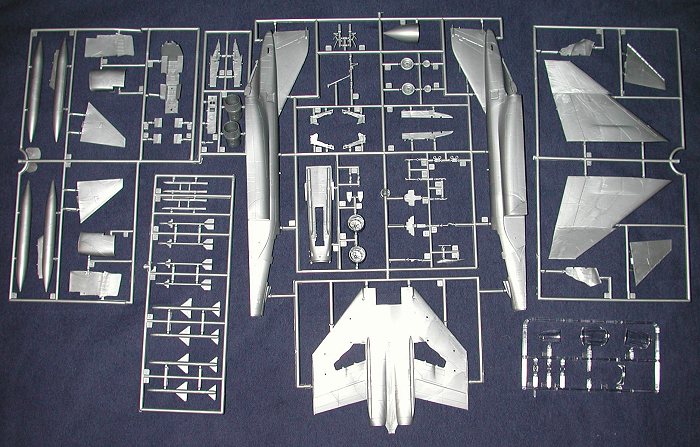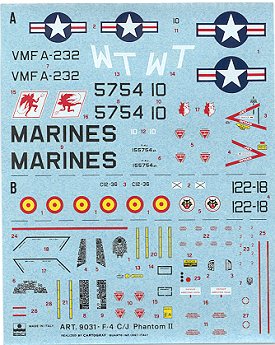
| KIT: | ESCI 1/72 F-4C/J Phantom II |
| KIT # | 9031 |
| PRICE: | $7.50 in the mid 1980s |
| DECALS: | See Review |
| REVIEW & | |
| NOTES: | Sadly, long OOP |

| HISTORY |
Once again, I am perplexed with what to say about the F-4Phantom II that hasn't been said a bunch of times before. Perhaps I can burn upsome ink by talking about the F-4 in the modeling community. Here on the brinkof the new millennium (Dec, 2000), it seems as if there is a resurgence ofinterest in the old Rhino. For years, it was a bit on the difficult side to finddecent kits of the F-4. Sure, it wasn't that tough to find the Monogram orHasegawa 1/48 models, but to find anything decent in 1/72 was increasinglydifficult.
Same with aftermarket stuff. Though now you can find all sortsof resin interiors in 1/48, there has yet to be a decent one done in 1/72.However, thanks to the non-production and scarcity of those hundreds (seemingly)of Microscale/Superscale decal sheets, some of the newer companies such asYellow Hammer, Eagle Strike, CAM, and Aeromaster have rediscovered the F-4 andhave been issuing sheets left and right. Still, most of these have been in 1/48,though some of them have had the decency to reissue them in 1/72.
So what is on the kit frontlines for 1/72 Phantoms. Well, ifyour hobby shop buys collections, you can still find the excellent FujimiPhantoms as well as those of ESCI and Italeri. From time to time the Monogram1/72 F-4s pop up and despite its age, they are very good kits. Then there isHasegawa. They make what are probably the best 1/72 F-4 kits around and haverecently issued several of them, each with different decals. However HasegawaF-4s are not easy to build and can be incredibly fiddly, thanks to trying to doall the variants in a modular fashion.
Probably the brightest light in the 1/72 F-4 sky are some newkits from Revell of Germany. They brought a new RF-4E and F-4F to the market inthe last few years. Though I have not seen either kit here in the US, they havehad good reviews from our friends in Europe. While the Rhino is slowlydisappearing from the skies, it seems that its future is still bright in the kitworld.
| THE KIT |

Both ESCI and Italeri brought out F-4 kits in the mid 1980s.Surprisingly, they were very similar to each other, both in layout and what wasoffered. Molded in silver plastic and with engraved panel lines, the ESCIF-4C/J kit can supposedly be built as either an F-4C or F-4J. Well, not really,but more about that later.
The kit comes with an Air Force style interior which has twoseats and two control sticks. The instrument panels and consoles have decals tocover them. Frankly the interior, while OK for 1985, is not that acceptable forthe 2000s. An aftermarket resin cockpit is very much needed. The floor of thecockpit is the roof of the nose gear well and has some detail.
The fuselage is typical of F-4 kits in that the intakes willprobably need filler, judging from having built a number of these. Thisparticular kit also had a number of rather deep sink marks where the alignmentpins and sockets are on this part as well as the wings. There are covers for theflare dispensers which are only on RF-4s. You are given two types of stabilizer,one with and one without the leading edge slots. Both have triangularreinforcement plates. Two different types of exhaust nozzles are also given; oneset for the F-4C and the other for the F-4J.
You can display the landing gear either up or down as you wish.The gear are wll done, though the forward nose gear door is not accurate for aUSN aircraft. If doing a C or J, you need to put the appropriate sensor underthe nose cone. The cockpit canopy can be displayed either open or closed.Finally, you get a full weapons load of four Sidewinders and four Sparrows. BothUSAF and USN styles of Sidewinder pylon are offered. There are also wing droptanks, but not one for the centerline.
 Instructions aretypical for ESCI in that they are very good and offer color callouts in allsteps. The color chart has both generic and FS595 callouts for all the colors.Decal options are for an F-4J in the gull grey and white for VMFA-232 or an F-4Cfor the Spanish Air Force in a standard SEA camouflage. ESCI decals work quitewell but are very matte.
Instructions aretypical for ESCI in that they are very good and offer color callouts in allsteps. The color chart has both generic and FS595 callouts for all the colors.Decal options are for an F-4J in the gull grey and white for VMFA-232 or an F-4Cfor the Spanish Air Force in a standard SEA camouflage. ESCI decals work quitewell but are very matte.
Well, I did mention that there might be a glitch or two in thiskit. It is also shared, if I remember, buy the Italeri one. It is that youreally cannot make a totally accurate Navy F-4 from it. The biggest problem isthe cockpit. Besides not being very good for an Air Force version, it is wrongfor a Navy one. The USN back seat has no side consoles except for a shortabbreviated one on the left side for the radio. There is no control stick in theback of Navy Phantoms, instead the RIO has a small joystick attached to theinstrument panel to control the radar. I also mentioned the USAF only nose geardoor. In addition, there should be small bumps on the upper wing where theaccess panels for the gear hinge go. This is found on both the F-4C (I think)and F-4J and is missing from this kit. Finally, only a few F-4Js had thetriangular reinforcement plate on the stabilizer. This can be easily sanded off,however. On the other side, you'll have to fill in the catapult strop attachmentpoints in the underside of the wing next to the intakes. The USAF version didn'thave them.
Now that I have said that, I can also mention that I gleefullyignored all that stuff when I was in my major F-4 building mode 15 years ago. Ididn't know and didn't care. All I knew was that the finished product lookedvery cool and it was enough for me. I'm sure that most modelers will be equallyas happy with the final product.
Overall, it is a nice kit and despite not being the latestand greatest, is well worth seeking tobuild. It has been OOP for about ten years, but can be found from time to time.
Review kit courtesy of me and my wallet!
If you would like your product reviewed fairly and fairly quickly by asite that has over 1,500 visits a day, please contactme or see other details in the